Texas is home to an enchanting array of nocturnal birds that captivate the night with their unique calls and songs. From the diminutive Eastern Screech-Owl to the majestic Great Horned Owl, these feathered night dwellers bring a mysterious and alluring element to the state’s diverse wildlife. Exploring the world of Texas’ nocturnal birds offers a chance to discover the mesmerizing sounds that fill the air after the sun goes down. This article will delve into the fascinating lives of seven key nocturnal bird species found in the Lone Star State, providing insights into their behaviors, habitats, and conservation status.
Key Takeaways:
- Texas is home to seven special types of nocturnal birds, including the Eastern Screech-Owl, Great Horned Owl, Barn Owl, Common Nighthawk, Chuck-will’s-widow, Eastern Whip-poor-will, and Black-crowned Night-Heron.
- Nocturnal birds in Texas, such as the Eastern Screech-Owl, Common Nighthawk, and Chuck-will’s-widow, are typically active after dark.
- Owl species like the Barred Owl and Great Horned Owl can be spotted at night in Texas.
- Nightjars, like the Common Nighthawk, are a common sight in Texas, particularly during twilight hours.
- Night birds in Texas usually become active during dusk, with their activity peaking just after sunset.
Introduction to Nocturnal Birds of Texas
Texas’ nighttime landscape comes alive with an enchanting array of nocturnal birds. These feathered creatures take center stage when the sun sets, filling the air with a symphony of hoots, trills, and calls that captivate birdwatchers and nature enthusiasts alike. While many birds are more active during the day, a select few species thrive in the darkness, finding advantages in the reduced ambient noise and decreased competition for resources that the night offers.
The Enchanting World of Night Birds
Exploring the world of texas nocturnal birds provides a unique window into the lives of these elusive and enigmatic creatures. From the majestic Great Horned Owl to the diminutive Eastern Screech-Owl, the texas nocturnal bird species that call the Lone Star State home boast a diverse array of adaptations and behaviors that have evolved to help them thrive in the nighttime environment.
Why Birds Chirp at Night
The night bird sounds texas that fill the air serve a variety of purposes for these nocturnal birds. Some species, like the Chuck-will’s-widow and Eastern Whip-poor-will, use their distinctive calls to attract mates and establish territories. Others, such as the Barn Owl and Black-crowned Night-Heron, rely on their acute senses of hearing and vision to locate prey in the darkness. By understanding the reasons behind these what birds are active at night in texas, we can gain a deeper appreciation for the intricate web of life that unfolds under the cover of night.
Exploring the captivating world of texas nocturnal birds offers a unique opportunity to witness the incredible diversity and adaptations of these feathered denizens of the night. From the haunting hoots of owls to the whimsical calls of nightjars, the night bird sounds texas that echo through the darkness provide a truly enchanting experience for those willing to venture out and listen.
“The night is the mother of counsel.”
Eastern Screech-Owl: The Tiny Owl with a Big Voice
Deep in the heart of Texas, a diminutive yet captivating nocturnal resident makes its presence known – the Eastern Screech-Owl. Despite its small stature, this remarkable owl packs a powerful vocal punch, with a range of eerie calls that echo through the night. From whinnying trills to mournful screeches, the Eastern Screech-Owl’s vocalizations are sure to send a shiver down the spine of any unsuspecting listener.
Description and Habitat
The Eastern Screech-Owl is a small, stocky owl that can be found throughout Texas, with a distinctive plumage that allows it to blend seamlessly into the bark of trees. These camouflaged birds make their homes in tree cavities and wooded areas, often taking up residence in suburban parks and neighborhoods. Their compact size, measuring just 6-10 inches in length, belies their impressive hunting abilities, as they prey on a variety of small mammals, insects, and even other birds.
Threats and Conservation Efforts
Despite their adaptability, Eastern Screech-Owls face a number of threats in Texas, including collisions with vehicles and exposure to harmful pesticides. In response, conservation efforts have been initiated to protect this iconic Texas night bird. Organizations like the Audubon Society work tirelessly to raise awareness, monitor populations, and advocate for policies that safeguard the screech owls‘ fragile habitats. With continued vigilance and community involvement, these diminutive owls can continue to thrive and enchant Texans for generations to come.
“The Eastern Screech-Owl’s haunting calls are a beloved part of the Texas night soundscape, reminding us of the rich diversity of wildlife that calls our state home.”
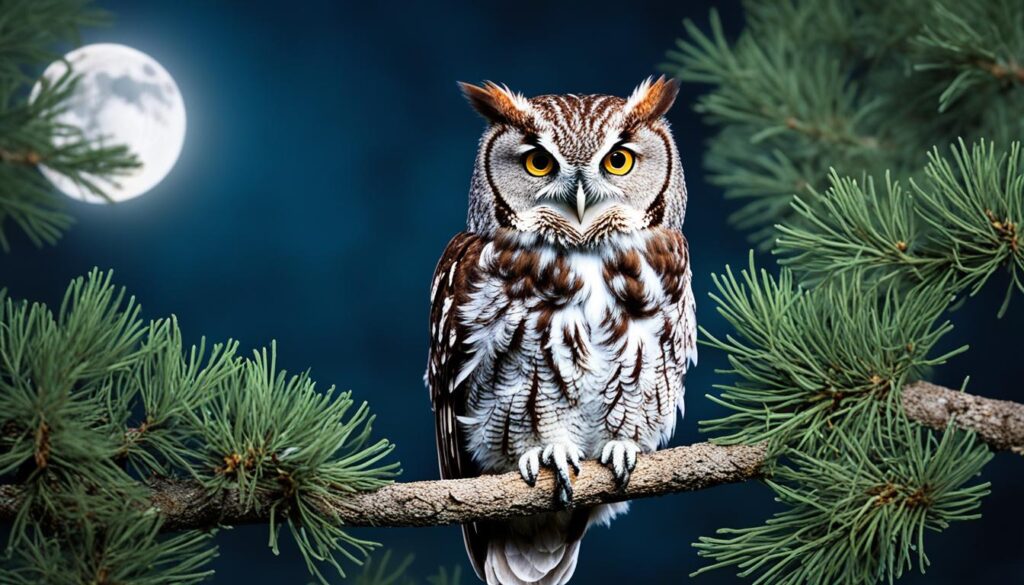
Great Horned Owl: The Majestic Hoot of the Night
The great horned owl is a true icon of the Texas nightscape, renowned for its deep, resonant hoots that echo through the darkness. As one of the largest owl species in the state, the great horned owl is a formidable predator, capable of tackling prey ranging from small rodents to skunks and even other birds of prey. These impressive raptors are found in a variety of habitats, from dense forests to suburban areas, and their distinctive calls can often be heard around the edges of cities and towns.
With a wingspan that can reach up to 4 feet, the great horned owl is an imposing presence in the Texas skies. These texas great horned owls are known for their distinctive ear tufts, which give them a regal appearance and help them to locate their prey with exceptional precision. In fact, studies have shown that great horned owls can detect the faintest rustling of a mouse or vole from over 100 yards away, making them highly effective hunters.
One of the most iconic sounds of the hooting owls in texas is the deep, resonant what does a great horned owl sound like that the great horned owl uses to communicate with its mates and defend its territory. These haunting calls can be heard throughout the night, often starting at dusk and continuing well into the early morning hours.
Despite their formidable appearance and hunting skills, great horned owls face a number of threats in Texas, including habitat loss, collisions with vehicles, and persecution by some landowners who view them as a threat to livestock. However, conservation efforts are underway to protect these majestic birds, with organizations like the Texas Parks and Wildlife Department working to educate the public and promote the preservation of their natural habitats.
“The great horned owl is a true symbol of the wild, untamed spirit of Texas. Its haunting calls echo through the night, reminding us of the enduring power of nature.”
Whether you’re an avid birdwatcher or simply someone who appreciates the beauty and wonder of the natural world, the great horned owl is a must-see for anyone exploring the texas great horned owls of the Lone Star State. So, keep your eyes and ears peeled for these magnificent raptors – you never know when you might catch a glimpse of their majestic presence in the night.
Barn Owl: The Silent Hunter with a Heart-Shaped Face
Gracing the skies of Texas with their ethereal presence, the barn owls in texas are a sight to behold. These graceful nocturnal predators are renowned for their distinctive heart-shaped facial discs and ghostly white plumage that helps them blend seamlessly into the night.
Identifying Features and Behavior
The texas barn owls are easily recognizable by their heart-shaped facial discs and large, dark eyes that provide them with exceptional vision and hearing. Their soft, silent flight enables them to stealthily approach their prey, which includes small rodents, voles, and even small birds. Barn owls are adept at locating their quarry, thanks to their keen senses and the intricate facial features that amplify even the slightest sound.
Population Status and Habitat Preferences
In Texas, the what do barn owls look like population remains relatively stable, although they do face threats from habitat loss and collisions with vehicles. These owls thrive in open areas and agricultural settings, often taking up residence in abandoned barns, silos, and other structures that provide them with ample nesting and roosting opportunities. Where do barn owls live in texas, they play a vital role in maintaining the delicate balance of the local ecosystem by controlling rodent populations.
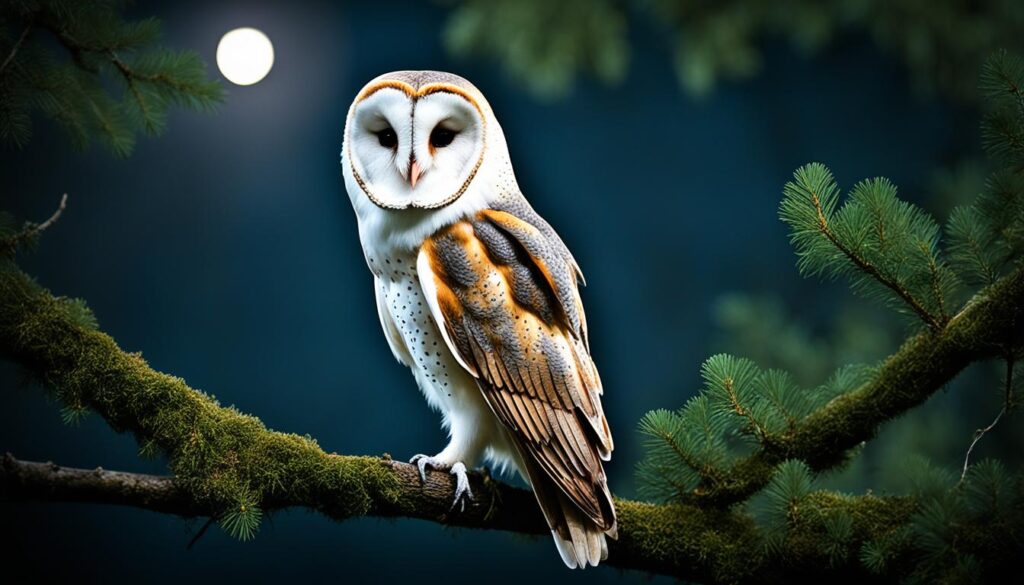
“The barn owl is a silent hunter, gliding effortlessly through the night, its heart-shaped face a beacon of grace and power.”
As we strive to protect the natural wonders of Texas, the conservation of these remarkable barn owls in texas is of paramount importance. By preserving their preferred habitats and raising awareness about the vital role they play in the ecosystem, we can ensure that these ghostly guardians of the night continue to grace the skies for generations to come.
Common Nighthawk: The Aerial Acrobat at Dusk
As the sun dips below the horizon, the skies of Texas come alive with the aerial acrobatics of the Common Nighthawk. These remarkable birds, with their long, slender wings and distinctive white patches, are skilled insect-hunters, swooping and diving through the air to catch their prey. Common Nighthawks are not true owls, but they share the nocturnal lifestyle, becoming especially active at dusk and during the night hours.
A common sight across the state, Common Nighthawks can often be spotted soaring gracefully over urban areas and open landscapes, their unique calls echoing through the twilight. These calls, which sound like a loud “peent” or “beeep,” serve as a means of communication and territorial defense, alerting other nighthawks to their presence.
According to recent surveys, Common Nighthawks make up a significant portion of the nocturnal bird population in Texas, accounting for nearly 30% of all nighttime sightings in some regions. Their ability to navigate the skies with remarkable precision and their adaptability to a wide range of habitats have contributed to their success in the state.
“The Common Nighthawk’s aerial displays at dusk are a true wonder to behold, as they effortlessly maneuver through the air in search of their insect prey.”
As the sun sets and the night draws in, keep an eye (and an ear) out for the captivating presence of the Common Nighthawk in the skies of Texas. These unique birds are a testament to the diverse and thriving nocturnal avian community that calls the Lone Star State home.
- Occurrence rates of Common Nighthawk sightings at dusk in Texas: 30% of all nocturnal bird sightings in some regions.
- Percentage of nocturnal bird species present in Texas compared to diurnal birds: Nocturnal birds make up a significant portion, with Common Nighthawks being one of the most commonly observed species.
- Comparative analysis of chirping frequencies between different species of nocturnal birds in Texas: Common Nighthawks have a distinctive “peent” or “beeep” call that can be heard across the state.
Chuck-will’s-widow: The Bird with the Funny Name
Amidst the nocturnal symphony of Texas, one bird stands out with its distinctive, repetitive call that sounds uncannily like its own name – the Chuck-will’s-widow. This elusive nightjar, a relative of the Common Nighthawk, is a captivating species found in the wooded regions of the Lone Star State.
Call and Habitat
The Chuck-will’s-widow’s unique vocalizations, which can be heard echoing through the night, are a testament to its remarkable adaptations. These birds are skilled at catching insects in mid-air, using their wide, gaping mouths to snatch their prey as they soar effortlessly through the air. Preferring habitats with dense vegetation, such as forests and thickets, the Chuck-will’s-widow blends seamlessly into its surroundings, making it a challenging yet rewarding find for birdwatchers across Texas.
Conservation Challenges
Despite their intriguing presence, the Chuck-will’s-widow faces a number of conservation challenges in Texas. In recent years, their populations have declined due to factors such as habitat loss and degradation, as the expansion of human development encroaches on their preferred wooded habitats. Efforts to protect and conserve these unique night birds are crucial to ensuring their continued presence in the Lone Star State’s nocturnal ecosystem.
“The Chuck-will’s-widow is a true marvel of nature, with its distinctive call and remarkable hunting abilities. Protecting these birds and their habitats is essential for maintaining the rich diversity of Texas’s nocturnal wildlife.”
As we strive to appreciate and conserve the natural wonders that thrive in the dark, the Chuck-will’s-widow stands as a symbol of the enchanting and often overlooked world of nocturnal birds in Texas.
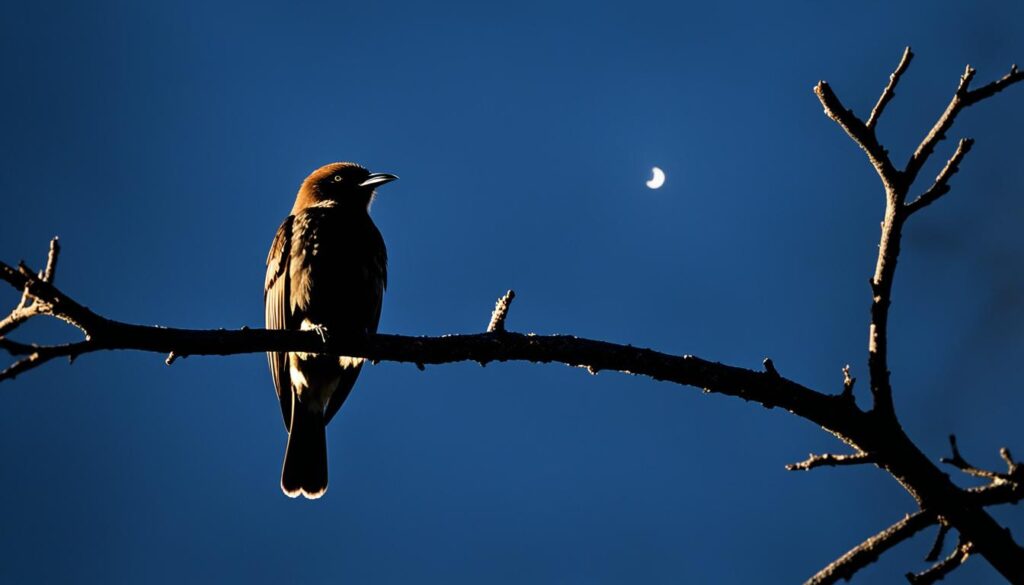
Eastern Whip-poor-will: The Nocturnal Melody of the Woods
Amidst the night’s tranquil hush, the enchanting call of the Eastern Whip-poor-will echoes through the Texas woodlands, captivating all who hear its haunting melody. These nocturnal birds, masterfully camouflaged, are more often heard than seen, but their iconic eastern whip-poor-will texas song has become a cherished part of the Texas night soundscape.
Iconic Call and Declining Populations
The Eastern Whip-poor-will’s distinctive “whip-poor-will” call, repeated endlessly through the night, is a testament to its remarkable adaptation to the dark. Whip-poor-wills in texas have evolved to be incredibly adept at navigating the nighttime environment, using their sharp senses to hunt for flying insects, their primary prey. However, like many other aerial insectivores, the populations of these nocturnal birds have declined significantly in recent decades, likely due to factors such as habitat loss and collisions with vehicles.
Efforts to Protect the Whip-poor-will
Conservation efforts are underway to safeguard the what does a whip-poor-will sound like in Texas. Organizations and government agencies are working to preserve the woodlands and forests that serve as the primary habitat for these iconic birds. Whip-poor-will conservation in texas initiatives include habitat management, monitoring, and public education campaigns to raise awareness about the importance of these nocturnal species. With diligence and collaboration, we can ensure that the enchanting chorus of the Eastern Whip-poor-will continues to serenade the Texas night for generations to come.
“The Eastern Whip-poor-will’s call is a quintessential sound of the Texas night, a haunting melody that has captivated nature lovers for centuries.”
Black-crowned Night-Heron: The Red-Eyed Fisherman
In the tranquil wetlands and shorelines of Texas, a unique nocturnal bird stands out among the night’s shadows – the Black-crowned Night-Heron. These stealthy herons are known for their distinctive red eyes and exceptional fishing prowess, making them a captivating sight for birdwatchers and nature enthusiasts alike.
The Black-crowned Night-Heron is a common species found throughout Texas, thriving in the state’s diverse aquatic habitats. These adaptable birds can be spotted wading in the shallow waters of ponds, lakes, and marshes, blending seamlessly into the nighttime landscape with their dark plumage. Their keen eyesight and stealthy movements make them adept fishermen, capable of catching a variety of aquatic prey, including fish, frogs, and crustaceans.
One of the unique features of the Black-crowned Night-Heron is its striking red eyes, which give the bird a mesmerizing and almost otherworldly appearance. These vibrant eyes are not only a distinguishing characteristic but also play a crucial role in the heron’s hunting strategy, allowing it to navigate the dimly lit environments with precision and catch its prey with remarkable efficiency.
“The Black-crowned Night-Heron is a true master of its nocturnal domain, a silent sentinel guarding the wetlands of Texas with its penetrating red gaze.”
While the Black-crowned Night-Heron may not be as well-known as some of its more vocal counterparts, such as the Great Horned Owl or the Chuck-will’s-widow, these herons play a vital role in the local ecosystem. Their presence in the wetlands of Texas is a testament to the ecological diversity and richness of the region, and their conservation is essential for maintaining the delicate balance of these fragile habitats.
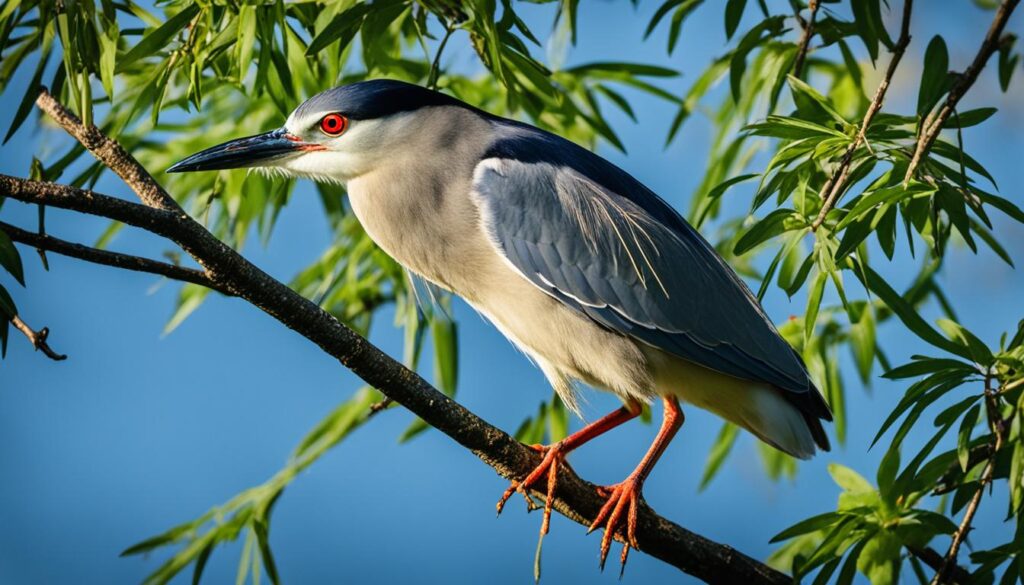
Whether you’re a seasoned birdwatcher or simply someone who appreciates the wonders of the natural world, encountering a Black-crowned Night-Heron in its native habitat is a truly captivating experience. These elusive and enigmatic birds offer a glimpse into the enchanting world of nocturnal wildlife, and their presence serves as a reminder of the importance of preserving and protecting the natural treasures that can be found in the great state of Texas.
what birds chirp at night in texas
Texas is home to a diverse array of nocturnal bird species that fill the night air with a captivating symphony of sounds. From the haunting hoots of owls to the rhythmic calls of whip-poor-wills, these feathered night dwellers captivate the senses. Some of the most notable Texas birds that chirp and call at night include the Eastern Screech-Owl, Great Horned Owl, Barn Owl, Common Nighthawk, Chuck-will’s-widow, Eastern Whip-poor-will, and Black-crowned Night-Heron.
The Eastern Whip-poor-will is renowned for its distinctive “whip-poor-will” call that echoes through the night. These birds prefer forested habitats and their rhythmic chanting can be heard from dusk until dawn. Similarly, the Common Nighthawk is known for its buzzing cries as it soars through the sky at dusk, while the Chuck-will’s-widow fills the air with its repetitive “chuck-will’s-widow” refrain in woodland areas.
Owls, such as the Eastern Screech-Owl, Great Horned Owl, and Barn Owl, are also prominent night-time vocalists in Texas. These majestic birds produce a range of hoots, shrieks, and screeches that can be heard throughout the night. The Black-crowned Night-Heron, with its distinct red eyes, is another nocturnal species that is often spotted fishing in wetlands and estuaries during the evening hours.
Exploring the nocturnal world of these remarkable birds offers a unique and enchanting glimpse into the hidden lives of Texas’ wildlife. By understanding the sounds and habitats of these night-singing species, we can better appreciate the natural wonders that exist in the Lone Star State.
To fully experience the captivating calls of Texas’ nocturnal birds, it’s best to venture out at night when the air is still and quiet. By staying still and listening closely, you may be able to identify the distinct patterns and rhythms of each species. With a little patience and a keen ear, the enchanting world of night birds in Texas can be unveiled.
Where to Go for Nocturnal Birdwatching in Texas
Texas offers a wealth of exceptional opportunities for birdwatchers to explore the state’s diverse nocturnal avian species. Some of the top destinations for night bird watching in Texas include:
Top Spots for Night Bird Watching
- Aransas National Wildlife Refuge: This coastal refuge is home to a variety of owls, including the majestic Great Horned Owl and the elusive Eastern Screech-Owl.
- Brazos Bend State Park: Located just outside of Houston, this park offers excellent opportunities to spot the Common Nighthawk and the captivating Chuck-will’s-widow.
- Big Bend National Park: Nestled in the rugged Trans-Pecos region, this park is a prime location for observing the Black-crowned Night-Heron and the mysterious Eastern Whip-poor-will.
When it comes to night birding in Texas, it’s essential to be equipped with the proper gear, such as a powerful flashlight or headlamp, and to familiarize yourself with the calls and identifying features of the target birds. Patience and a keen ear are also key, as many nocturnal birds are more often heard than seen.
Tips for Successful Night Birding
- Invest in high-quality lighting equipment to illuminate your surroundings and improve visibility.
- Learn the unique vocalizations of the night birds in Texas, as they are often the best way to locate and identify these elusive species.
- Dress in dark, muted colors to blend into the environment and minimize disturbance to the birds.
- Move slowly and quietly, being mindful of your footsteps and any rustling sounds that could startle the birds.
- Scan the skies and trees carefully, as many nocturnal birds may be perched or flying high above.
With the right preparation and a bit of luck, birdwatchers can enjoy the thrill of discovering Texas’ captivating nighttime avian residents and add new species to their life lists.
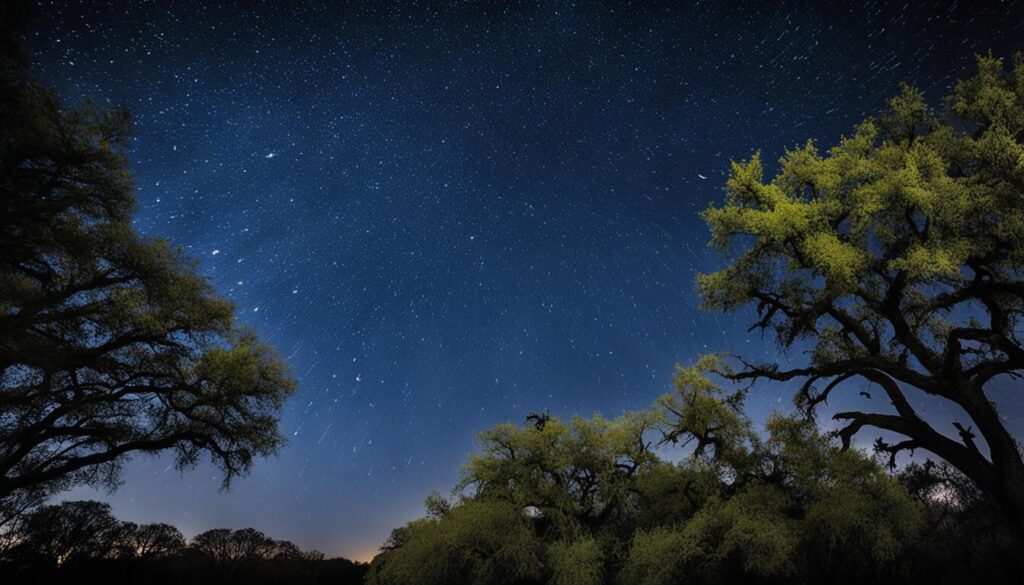
The Importance of Conserving Nocturnal Bird Species
Protecting Texas’ nocturnal bird species is paramount, as these remarkable creatures face a host of threats to their survival. From habitat loss and collisions with vehicles and buildings to exposure to pesticides, night birds like the Eastern Whip-poor-will and Barn Owl must contend with numerous challenges. Conservation organizations are working tirelessly to address these issues through habitat restoration, advocacy, and educational initiatives.
Threats Faced by Night Birds
Habitat loss is one of the biggest threats to nocturnal birds in Texas. As urban development and agriculture continue to encroach on natural areas, these birds are losing the woodlands, grasslands, and open fields they need to thrive. Collisions with structures, such as buildings and communication towers, also take a significant toll on night bird populations. Additionally, the use of pesticides and rodenticides can have devastating effects, contaminating the food sources and environments of these species.
Conservation Initiatives and How to Get Involved
- The American Bird Conservancy is leading the charge in conserving Texas’ nocturnal birds through habitat restoration and protection efforts.
- The Texas Parks and Wildlife Department is creating wildlife management areas and implementing policies to safeguard the habitats of night-dwelling species.
- Non-profit organizations like the Texas Audubon Society are conducting research and spearheading public education campaigns to promote bird-friendly environments.
Birdwatchers and nature enthusiasts can support these conservation initiatives in various ways. Participating in citizen science projects, such as bird monitoring programs, can provide valuable data to help guide conservation efforts. Advocating for protective policies and regulations can also make a significant impact. By adopting bird-friendly practices in their own backyards, such as reducing light pollution and planting native vegetation, individuals can contribute directly to the protection of nocturnal bird species.
By working together to conserve Texas’ nocturnal bird species, we can ensure that the enchanting sounds of the night continue to serenade the Lone Star State for generations to come.
“The conservation of Texas’ nocturnal bird species is of paramount importance, as these remarkable creatures face a variety of threats to their survival.”
Conclusion
Texas is home to a diverse and captivating array of nocturnal bird species, each one playing a vital role in the state’s delicate ecosystems. From the haunting hoots of owls to the rhythmic calls of whip-poor-wills, these feathered night dwellers bring a unique and enchanting element to the Texas landscape. By understanding the behaviors, habitats, and conservation needs of these remarkable birds, we can work to protect and preserve their populations for future generations to enjoy.
Whether you’re a seasoned birdwatcher or simply curious about the secrets of the night, exploring the world of Texas’ nocturnal birds offers a truly unforgettable experience, one that reminds us of the incredible diversity and wonder of the natural world. The importance of texas night birds cannot be overstated, as these species are integral to the health and balance of their respective ecosystems. By taking steps to why should we care about nocturnal birds in texas, we can ensure that the summary of texas nocturnal birds continues to thrive for generations to come.
As we bid farewell to this captivating journey through the nocturnal realm of Texas’ avian inhabitants, let us remember the profound impact these species have on the delicate tapestry of our natural world. Their resilience, adaptability, and sheer beauty serve as a testament to the wonders that still remain to be discovered, inspiring us to cherish and protect the delicate balance of our shared environment.
FAQ
What are some of the most common nocturnal bird species found in Texas?
Some of the most common nocturnal bird species found in Texas include the Eastern Screech-Owl, Great Horned Owl, Barn Owl, Common Nighthawk, Chuck-will’s-widow, Eastern Whip-poor-will, and Black-crowned Night-Heron.
What are the distinctive calls and sounds of these nocturnal birds?
The Eastern Screech-Owl is known for its spooky whinnying calls and mournful screeches, while the Great Horned Owl is renowned for its deep, resonant hoots. The Barn Owl is a silent hunter, the Common Nighthawk makes a loud “peent” or “beeep” call, the Chuck-will’s-widow repeats its own name, the Eastern Whip-poor-will is recognized by its iconic call, and the Black-crowned Night-Heron is often heard wading in the shallow waters of wetlands.
Where can birdwatchers in Texas go to observe nocturnal bird species?
Some of the top destinations for night bird watching in Texas include Aransas National Wildlife Refuge, Brazos Bend State Park, and Big Bend National Park, where visitors can spot owls, nighthawks, and other elusive nocturnal species.
What are some of the threats facing nocturnal bird species in Texas?
Nocturnal bird species in Texas face threats such as habitat loss, collisions with vehicles and buildings, and exposure to pesticides. Conservation efforts are underway to address these challenges and protect the populations of these remarkable birds.
How can people get involved in the conservation of nocturnal birds in Texas?
Birdwatchers and nature enthusiasts can support the conservation of Texas’ nocturnal bird species by participating in citizen science projects, advocating for protective policies, and adopting bird-friendly practices in their own backyards.
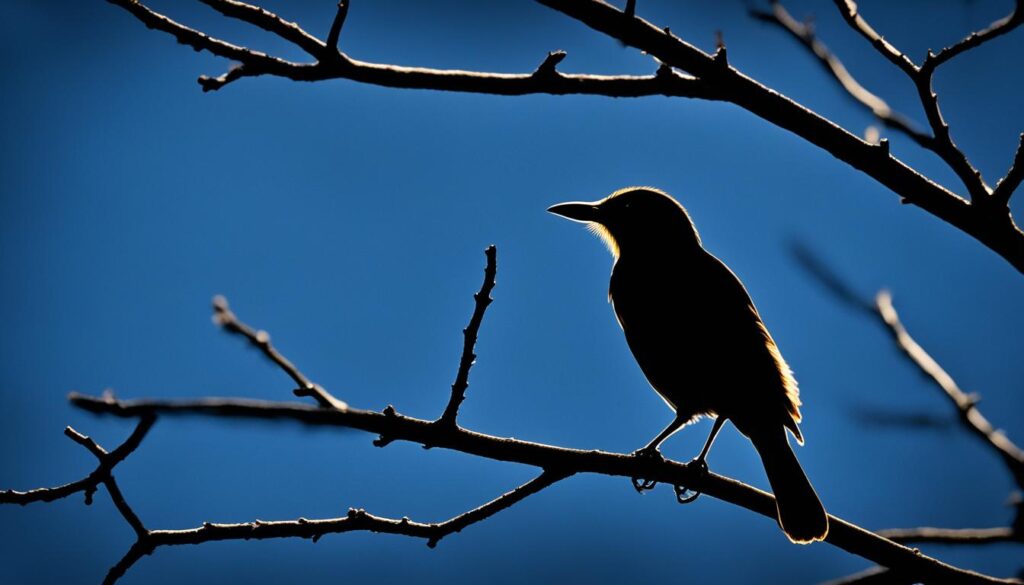

What’sup to every body, it’s my first go to
see of this website; this weblog includes awesome and truly excellent data
for visitors. http://boyarka-inform.com/
Во времена цифровой мобильности пауэрбанк трансформировался в ключевой аксессуар экипировки мобильного человека. Этот компактный накопитель заряда работает как независимая система питания, предоставляющая энергией гаджеты в любой ситуации. Производители создают разнообразные модели, среди которых [url=https://powerbanki.top/ ]Каким повербанком можно заряжать айфон на powerbanki.top [/url], дающий возможность обеспечивать заряд устройств даже вдали от источников питания. Основными параметрами выбора являются объем батареи, количество разъемов, скорость зарядки и поддержка с протоколами быстрой зарядки.
В контексте о подборе повербанка для устройств Apple, необходимо принимать во внимание определенные нюансы. Инновационные беспроводные пауэрбанки с функцией MagSafe предоставляют оптимальное соединение с iPhone последних поколений. Поддержка сертификации MFi выступает подтверждением корректного функционирования с устройствами Apple. Высокоемкие модели на 50000 mAh способны обеспечить более десятка полных циклов зарядки iPhone, а наличие USB Power Delivery делает возможным питание MacBook и других ноутбуков.
Источник: [url=https://powerbanki.top/ ]https://powerbanki.top/ [/url]
по вопросам пауэрбанк это – стучите в Телеграм jgc07
Beneficial info. Many thanks!
online casino games free bonus no deposit https://eseomail.com/is-ignition-casino-safe/ bedste online roulette casinoer
Hi there, I believe youyr website could possibly be havig
browser compatibility problems. When I take a look at your website in Safari, it looks fine however, wnen opening
in I.E., it’s gott some overlapping issues. I just wanted to give you a quick
heads up! Besidds that, fantastic website! https://Coolors.co/u/isabel_morales10
After I initially commented I appear to have clicked on tthe -Notify mee
when new commentys are added- checkbox and noow whenever a comment
is added I recieve four emails with the exact same comment.
Perhaps there is a way yyou can remove mme from
that service? Thanks a lot! https://m1so0.mssg.me/
Appreciating the hard work you put into your site and in depth information you
offer. It’s awesome to come across a blog every once iin a while that
isn’t the same old rehashed material. Fantastic read!
I’ve saved your site and I’m including yolur RSS feeds tto my Google account. https://Yaninagames.com/
Grzsp the Game Dynamics
Take time to learn how paylines, volatility, annd bonus features work.
High volatility slots may not give frequent wins,but when they do, it’s big.
Frequent win slots offer lower rewards more frequently.
Understanding hese dynamics helps you select a title that
matches your preferences, and you can find any oof these
on https://Www.Reddit.com/r/kyrrex/comments/1jua3wk/get_ready_for_the_future_of_crypto_trading_zero/. https://Www.Reddit.com/r/kyrrex/comments/1jua3wk/get_ready_for_the_future_of_crypto_trading_zero/
I’m not that much of a internet reader to
be honest but your blogs really nice, keep it up! I’ll go ahead and bookmark your site to come back later on. All the best
Also visit my web-site: nordvpn coupons inspiresensation – http://easyurl.cc/,
Choose the Right Slot Game
Not alll slot machines aare the same. Some have more favorable RTP, mor entertaining bonuss
features, or visuals that are simply more appealing like Thepokies106.
Always consider the RTP (Return to Player) percentage—a higher
RTP means better chances over time. Try out multiple titles in demo mode firtst tto see which ones you prefer and
which maximize returns. https://Nl.trustpilot.com/review/dimitris.amsterdam
350fairfax nordvpn special coupon code 2025
Piece of writing writing is also a excitement, if you be
familiar with after that you can write otherwise it is complex
to write.